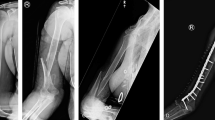Abstract
Background
The purpose of this study is to determine the effects of energy mechanism on outcomes following repair of proximal humerus fractures (PHF) in the middle aged and geriatric population.
Methods
Two hundred sixty-nine patients who presented to our academic medical center between 2006 and 2020, and underwent operative treatment of a proximal humerus fracture were prospectively enrolled in an IRB-approved database. Patients above 55 were divided into high energy (motor vehicle accident, pedestrian struck, or fall > 2 stairs) or low energy mechanisms (fall from standing or < 2 stairs). Of 97 patients with complete documentation and follow-up, 72 were included in the low velocity (LV) group and 25 were included in the high velocity (HV) group. Demographic information, primary injury details, healing and time to union, range of motion (ROM), complications, and need for reoperation were assessed at initial presentation and subsequent follow-up appointments.
Results
Mean age, BMI, and gender were significantly different between the LV and HV cohorts (p = 0.01, 0.04, 0.01). OTA/AO fracture patterns were similar between the groups. (p = 0.14). Bony healing and complications occurred with similar frequency between groups (p = 1.00, 0.062). The most common complications in the LV and HV groups included avascular necrosis (9.7%, 16.0%), and screw penetration (4.2%, 12.0%), while the HV group also had rotator cuff issues including weakness and tendonitis (12.0%). There was no significant difference in need for reoperation between cohorts (p = 0.45). Time to healing, shoulder ROM, and DASH scores did not differ between each group.
Conclusions
Energy and mechanism demonstrates similar outcomes in operatively treated proximal humerus fractures. These factors should not play a role in decisions for surgery in these patients and can help guide patient expectations.
Similar content being viewed by others
References
Court-Brown CM, Caesar B (2006) Epidemiology of adult fractures: a review. Injury 37(8):691–697. https://doi.org/10.1016/j.injury.2006.04.130
Kim SH, Szabo RM, Marder RA (2012) Epidemiology of humerus fractures in the United States: nationwide emergency department sample, 2008. Arthritis Care Res (Hoboken) 64(3):407–414. https://doi.org/10.1002/acr.21563
Court-Brown CM, Garg A, McQueen MM (2001) The epidemiology of proximal humerus fractures. Acta Orthop Scand 72(4):365–371. https://doi.org/10.1080/000164701753542023
Roux A, Decroocq L, El Batti S et al (2012) Epidemiology of proximal humerus fractures managed in a trauma center. Orthop Traumatol Surg Res 98(6):715–719. https://doi.org/10.1016/j.otsr.2012.05.013
Launonen AP, Lepola V, Saranko A, Flinkkilä T, Laitinen M, Mattila VM (2015) Epidemiology of proximal humerus fractures. Arch Osteoporos 10:209. https://doi.org/10.1007/s11657-015-0209-4
Hilaire CS, Johnson A, Loseth C et al (2020) Facial fractures and associated injuries in high-versus low-energy trauma: all are not created equal. Maxillofac Plast Reconstr Surg 42(1):22. https://doi.org/10.1186/s40902-020-00264-5
Cecil A, Yu JW, Rodriguez VA et al (2020) High- versus low-energy acetabular fracture outcomes in the geriatric population. Geriatr Orthop Surg Rehabil 11:2151459320939546. https://doi.org/10.1177/2151459320939546
Dyskin E, Hill BW, Torchia MT, Cole PA (2019) A survey of high- and low-energy acetabular fractures in elderly patients. Geriatr Orthop Surg Rehabil 10:2151459319870426. https://doi.org/10.1177/2151459319870426
Renninger CH, Cochran G, Tompane T, Bellamy J, Kuhn K (2017) Injury characteristics of low-energy lisfranc injuries compared with high-energy injuries. Foot Ankle Int 38(9):964–969. https://doi.org/10.1177/1071100717709575
Ibrahim DA, Swenson A, Sassoon A, Fernando ND (2017) Classifications in brief: the tscherne classification of soft tissue injury. Clin Orthop Relat Res 475(2):560–564. https://doi.org/10.1007/s11999-016-4980-3
Valderrama-Molina CO, Estrada-Castrillón M, Hincapie JA, Lugo-Agudelo LH (2014) Intra- and interobserver agreement on the Oestern and Tscherne classification of soft tissue injury in periarticular lower-limb closed fractures. Colomb Med (Cali) 45(4):173–178
Sproul RC, Iyengar JJ, Devcic Z, Feeley BT (2011) A systematic review of locking plate fixation of proximal humerus fractures. Injury 42(4):408–413. https://doi.org/10.1016/j.injury.2010.11.058
Vijayvargiya M, Pathak A, Gaur S (2016) Outcome analysis of locking plate fixation of proximal humerus fracture. J Clin Diagn Res 10(8):RC01-5. https://doi.org/10.7860/JCDR/2016/18122.8281
Laux C, Grubhofer F, Werner CML, Simmen HP, Osterhoff G (2017) Current concepts in locking plate fixation of proximal humerus fractures. J Orthop Surg Res 12(1):137. https://doi.org/10.1186/s13018-017-0639-3
Kavuri V, Bowden B, Kumar N, Cerynik D (2018) Complications associated with locking plate of proximal humerus fractures. Indian J Orthop 52(2):108–116. https://doi.org/10.4103/ortho.IJOrtho_243_17
Nowak LL, Dehghan N, McKee MD, Schemitsch EH (2018) Plate fixation for management of humerus fractures. Injury 49(Suppl 1):S33–S38. https://doi.org/10.1016/S0020-1383(18)30300-0
Beeres FJP, Hallensleben NDL, Rhemrev SJ et al (2017) Plate fixation of the proximal humerus: an international multicentre comparative study of postoperative complications. Arch Orthop Trauma Surg 137(12):1685–1692. https://doi.org/10.1007/s00402-017-2790-z
Campochiaro G, Rebuzzi M, Baudi P, Catani F (2015) Complex proximal humerus fractures: Hertel’s criteria reliability to predict head necrosis. Musculoskelet Surg 99(Suppl 1):S9-15. https://doi.org/10.1007/s12306-015-0358-z
Gitajn IL, Castillo R, Breazeale S et al (2017) Survivorship after high-energy geriatric trauma. J Orthop Trauma 31(8):e230–e235. https://doi.org/10.1097/BOT.0000000000000864
Funding
No funding was provided to conduct this study.
Author information
Authors and Affiliations
Corresponding author
Ethics declarations
Conflict of interest
Dr. Abhishek Ganta is a consultant for Integra. Dr. Sanjit Konda is a consultant for the Stryker Corporation. Dr. Egol is a consultant for Exactech.
Additional information
Publisher's Note
Springer Nature remains neutral with regard to jurisdictional claims in published maps and institutional affiliations.
Rights and permissions
Springer Nature or its licensor holds exclusive rights to this article under a publishing agreement with the author(s) or other rightsholder(s); author self-archiving of the accepted manuscript version of this article is solely governed by the terms of such publishing agreement and applicable law.
About this article
Cite this article
Ganta, A., Solasz, S., Drake, J. et al. Does mechanism of injury impact the outcome of operative fixation of geriatric proximal humerus fractures. Arch Orthop Trauma Surg 143, 4095–4098 (2023). https://doi.org/10.1007/s00402-022-04616-w
Received:
Accepted:
Published:
Issue Date:
DOI: https://doi.org/10.1007/s00402-022-04616-w




